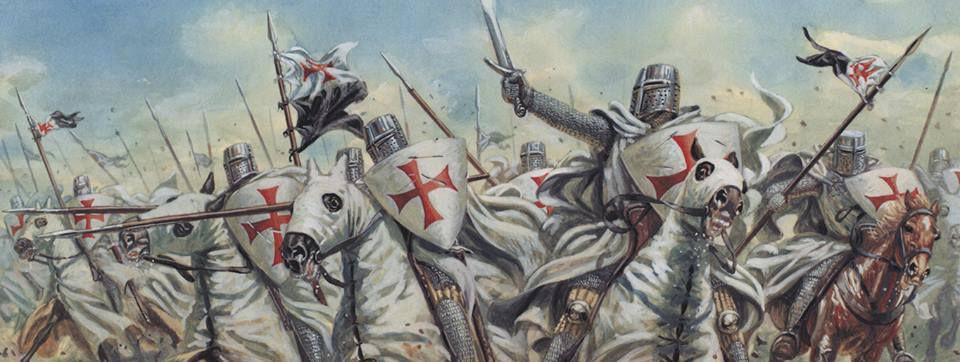Answering the Crusades' Critics: Part 3

The Crusaders
Augustine’s Just War Theory, developed around the turn of the fifth century, provided the basis upon which the popes called for the recla-mation of the Holy Land for Christendom. Simplified, it contained three propositions: First, the war must have a just cause, usually ag-gression of or injury by another. Second, it must rest on the authority of the prince. In other words, it had to be proclaimed by a legitimate authority. And finally, it had to have right intention. Participants were to have a pure motive and war had to be the only means remaining of achieving the justifiable objective.[15]
Christian writers were generally in agreement that the just
cause for a war must be reactive. It was just to defend
one’s country, laws and traditional way of life, just to try
to recover property unlawfully taken by another, perhaps
even just to enforce by physical means a properly deliver-
ed judicial sentence. It was not legitimate to wage a war of
aggrandizement or conversion… The justification for the
crusade, therefore, was the reconquest of Christian ter-
ritory, and especially Christ’s own patrimony, which had
been usurped by the Muslims, and the pope’s appeal was
presented in such a way that it conformed to the criterion
of a just cause.[16]
Urban II blended Just War Theory with Christian concepts of charity and pilgrimage to round out the crusade model. Because the Crusades were pilgrimages, albeit pilgrimages under arms, they were open to anyone. Modern historians have mistakenly believed “the crusades were manned by Europe’s castoffs: aristocratic second or third sons with no claim to their father’s land or title, robber barons, highwaymen, ne’er-do-wells, and greedy monks.”[17] But analysis by Riley-Smith reveals that a vast majority of the 150,000 who answered Urban II’s call were poor, and many were women or elderly (or both).[18] Equally surprising is that of the knightly crusaders that did go, a vast majority “were not spare sons but the lords of their estates. It was not those with the least to lose who took up the cross, but rather those with the most.”[19]
Furthermore, the cost of crusading was enormous. It was necessary for a knight to raise funds equal to five or six times his annual income to fi-nance his expedition. Many were forced to sell property, liquidate as-sets and even settle property disputes to their disadvantage. Often, family members made these same sacrifices in order to contribute to the crusader’s journey.[20] Quite frankly, many crusaders were left ruined, certainly the poorer of those who took up the cross.
Another popular generalization is that crusaders were attracted by the prospect of material gain, either in the form of coloniza-tion or booty.
[But] most of the crusaders returned home once Jerusa-
lem had fallen to them… [and] with no proper system of
provisioning, the early crusaders had to forage to survive,
which explains their obsession with loot, but any plunder
gained towards the end of the crusade would have been
dissipated on the return journey, even supposing that men
could have found the physical means to carry it home.[21]
In sum, the vast majority of crusaders were poor and/or elderly. Of the noble class, it was actually those with the most to lose who answered the call and many were actually bankrupted by the Crusades. Booty was not a significant motivator; “the last thing most sensible crusaders would have expected was material gain.” [22] And while some colonies were established, these were not an effort at proto-colonial expansion. Some colonies had to be established to keep what was won. It would make no sense to successfully take Jerusalem only to abandon her after. Her enemies beset the Holy Land on all sides; pockets of Chris-tian territory could hardly be called colonies so much as attempts to survive. As far as “power-mad” popes are concerned, Thomas Asbridge acknowledges that Roman ecclesiastical authority may have been consolidated to varying degrees in some regions, but for the most part “many medieval popes seem earnestly to have believed that they had a wider duty to protect Christendom.” [23] Given all of this, it is no wonder Jonathan Riley-Smith says, “One cannot avoid concluding that crusading was a genuine devotional activity.”[24]
Next, we'll see that many critiques of the Crusades are aimed at Christians and/or Christianity and look at appropriate theological-apologetic responses to those criticisms.
[15] Riley-Smith, What Were the Crusades, 6.
[16] Ibid., 9,14, emphasis mine.
[17] Madden, The New Concise History of the Crusades, 11.
[18] Ibid., 12.
[19] Ibid.
[20] Ibid.
[21] Riley-Smith, What Were the Crusades, 72-73.
[22] Ibid., 73.
[23] Thomas Asbridge, The Crusades: The Authoritative History of the War for the Holy Land
[24] Riley-Smith, What Were the Crusades, 73.





